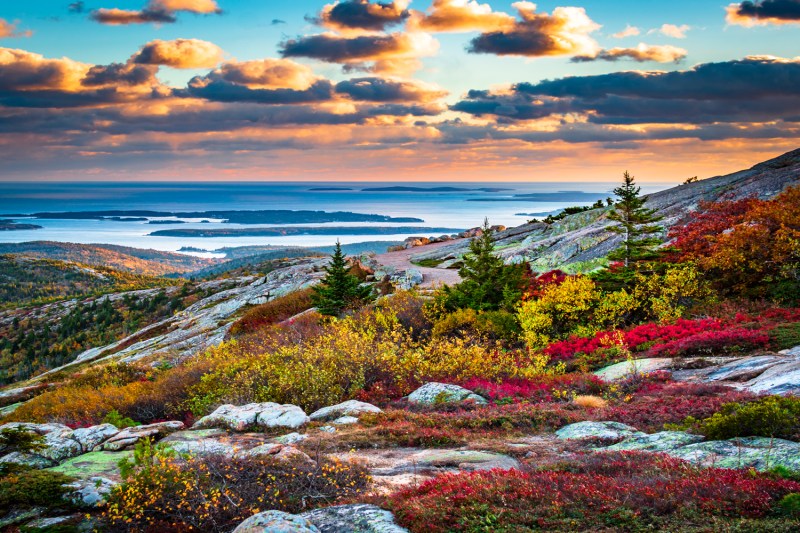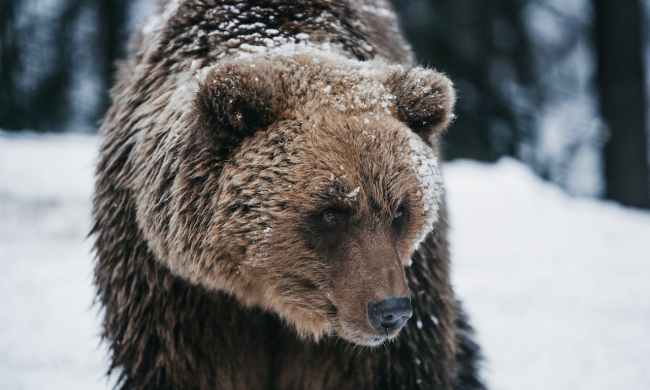Located along the rugged coast of Maine, Acadia National Park spans much of Mount Desert Island and covers over 47,000 acres of shorelines, forests, meadows, and mountains. When you visit this national treasure, you’ll encounter granite peaks with sweeping views of the Atlantic, which is sure to make your heart soar.
Acadia is open year-round and it’s a popular place for all kinds of seasonal activities. The best time to visit Acadia National Park depends on your goals and preferences, so let’s run through the options to see what best fits you and your fellow adventurers.
Acadia National Park in the fall

If you’re drawn to the fiery colors of fall, Acadia National Park in this season is a real treat. Because of the stunning palette of reds, oranges, and yellows, you may still encounter crowds, but the cooler air is worth it. The weather tends to range from 40 to 70 degrees Fahrenheit during the day, but it can certainly get below freezing at the night.
Activities
- Foliage viewing: The park’s vibrant autumn colors are a must-see. Great spots include Jordan Pond, Eagle Lake, and the top of Cadillac Mountain. If you go to Cadillac Mountain, be sure to place a reservation.
- Ocean Path: For an easy 4.4-mile roundtrip scenic hike, try the Ocean Path, which follows the coastline from Sand Beach to Otter Point. This is a great trail for all skill levels, with views of iconic landmarks like Thunder Hole and Gorham Mountain.
- Precipice Trail: A 2.5-mile roundtrip might not sound that bad, but Precipice Trail is incredibly strenuous, particularly once you get to Champlain Mountain, where you will need to navigate narrow ledges, ladders, and even iron rungs to reach the summit. Needless to say, this one isn’t for the faint of heart.
What to expect: Weekdays are quieter, but weekends can remain busy until mid-October. Be prepared for chilly mornings and evenings as temperatures drop.
Acadia National Park in the winter

Like many national parks, Acadia is transformed into a snow-covered landscape in winter. While many services close for the season, the park offers plenty of winter-specific activities for those looking for a quieter, off-peak experience. Temperatures usually hover between 15 and 35 degrees Fahrenheit, with snow, ice, and strong winds.
Activities
- Cross-country skiing: The park’s carriage roads become groomed trails perfect for cross-country skiing, offering about 45 miles of peaceful winter paths.
- Snowshoeing: Snowshoeing through Acadia’s quiet, snowy trails, such as the Jordan Pond Path, is a great way to explore the park in winter.
- Winter hiking: Some trails, like Wonderland Trail, remain accessible, but you’ll need ice traction gear like crampons or spikes for safety.
- Winter drives: While most roads are closed to vehicles, snowmobiles and pedestrians can use sections of the Park Loop Road and the Schoodic Peninsula, which have great coastal winter views.
What to expect: Winter sees the fewest visitors. Most facilities, including visitor centers, are closed, and road conditions can be tricky. Make sure to have appropriate winter gear and be prepared for extreme weather.
Acadia National Park in the spring

If you want to avoid the summer crowds and don’t mind cooler temperatures, spring at Acadia National Park might be the best time to visit. But be warned, trails can be incredibly muddy as the ground thaws. For this reason, you may wish to stay on paved trails. However, there’s still plenty to do as life returns to the park. Daytime temperatures typically range from 30 to 60 degrees Fahrenheit, so don’t forget your cold-weather gear.
Activities
- Hiking: As snow melts at lower elevations, trails like Ocean Path and Jordan Pond Path become accessible, and you’ll be the first to see the flowers come alive.
- Bird-watching: Spring marks the beginning of bird migration, with species such as eagles and warblers making their way back to the park. With over 300 species of birds, Acadia has some of the best bird-watching around. You might also see other wildlife, such as moose, deer, and foxes.
- Biking: While you can bike for most of the year at Acadia, spring is when the historical carriage roads open up for leisurely activities. These roads are ideal for cycling, with over 45 miles of traffic-free paths.
What to expect: Some trails and services may still be closed early in the season, and weather can be unpredictable. Dress in layers to stay comfortable as temperatures vary.
Acadia National Park in the summer

Once summer hits, the warm weather comes with its own charm and challenges. While the days are warmer and the foliage is greener, it’s also the time of year when Acadia National Park sees the highest levels of crowds. The entire park and all its amenities are fully operational, but there are also plenty of activities that aren’t open during any other time of year. Daytime temperatures generally range from 50 to 80 degrees Fahrenheit, though it can feel warmer due to the coastal humidity.
Activities
- Hiking: All the trails we previously mentioned are open for business during the summer, including iconic ones, such as Beehive Trail. The weather is great for reaching high-elevation viewpoints like the Precipice Trail, and you’ll be rewarded with unparalleled views.
- Catch the sunrise on Cadillac Mountain: Cadillac Mountain is one of the first places to see the sunrise in the U.S. In the summer months, the sun rises early, but it’s worth the early start for this unforgettable experience. Don’t forget to make a reservation, though.
- Boating and kayaking: Explore the park’s lakes or the coastal areas by kayak or take a boat tour around nearby islands for a closer look at the region’s marine life.
- Ranger programs: In the summer, park rangers offer guided hikes, stargazing programs, and talks about Acadia’s wildlife, history, and geology.
What to expect: Summer brings large crowds, especially on weekends and holidays. Parking can be limited, so using the free Island Explorer Shuttle is a great way to avoid the hassle of finding a spot.
Acadia National Park is definitely worthy of your bucket list. If you want to get the most out of your adventure, brave the summer crowds by planning your trip around a weekday. However, the crisp fall air won’t steer you wrong. With cooler temperatures and gorgeous fall colors, you’ll enjoy every second of your trip. For winter adventurers, you can plan an unforgettable cross-country ski or snowmobile trip through the miles of trails in the area. Or, if you have an eye for bird-watching, you won’t want to miss spring. No matter the season, Acadia National Park has something for you.




